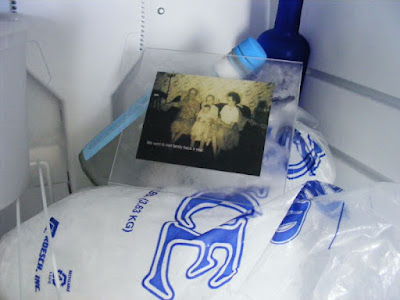I took some more pictures of the luminaries in the workshop in Mount Carroll the past weekend:
As you can see, each one will be about six feet high. All I have to do now is to transfer the images to the plexiglass panels, before final assembly a week before the unveiling on October 30th. To that end, I experimented with using Lazertran on small pieces of plexiglass. Lazertran comes in sheets that you can run through an inkjet printer, thus printing out any image that you've stored on your laptop. You soak the Lazertran in warm water for about 30 seconds, and then the image is released from the backing paper, enabling you to slide it off onto the plexiglass (or any other surface). The gum on the back of the image is enough to adhere it to the plexiglass surface. It's basically a high-quality decal.
To test the bond and to subject it to temperature similar to how it'll be outdoors in northern Illinois in November, I left a couple of pieces of plexiglass with Lazertran-sfers on them in the freezer overnight:
The result of my little science experiment was that the images seemed to stay on the panels nicely. I propped them, still foggy from the icy freezer, against the kitchen window:
 Subscribe to Praeterita in a reader
Subscribe to Praeterita in a reader
As you can see, each one will be about six feet high. All I have to do now is to transfer the images to the plexiglass panels, before final assembly a week before the unveiling on October 30th. To that end, I experimented with using Lazertran on small pieces of plexiglass. Lazertran comes in sheets that you can run through an inkjet printer, thus printing out any image that you've stored on your laptop. You soak the Lazertran in warm water for about 30 seconds, and then the image is released from the backing paper, enabling you to slide it off onto the plexiglass (or any other surface). The gum on the back of the image is enough to adhere it to the plexiglass surface. It's basically a high-quality decal.
To test the bond and to subject it to temperature similar to how it'll be outdoors in northern Illinois in November, I left a couple of pieces of plexiglass with Lazertran-sfers on them in the freezer overnight:
The result of my little science experiment was that the images seemed to stay on the panels nicely. I propped them, still foggy from the icy freezer, against the kitchen window:


